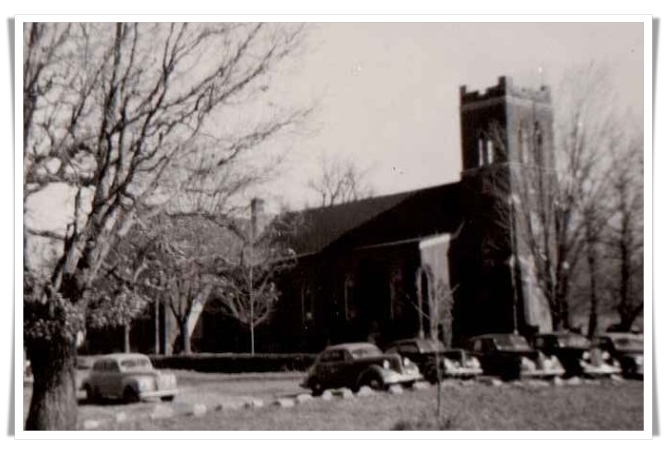History of Bethel Presbyterian Church

Bethel’s history from 1746 to 1974 is described in depth in Bethel and Her Ministers written by Herbert S. Turner, D.D., to commemorate our 200th anniversary in 1946 and updated to include later years with the help of James Sprunt, D.D.
In Dr. Turner’s words “To have rounded out 200 years of history and still remain strong and vigorous is a glorious achievement for any institution. It tells a story of splendid service through the years. The church founded in pioneer days by men of faith and vision… was responsible more than any other factor for that type of culture which has come to be associated with the Valley of Virginia.”
The first settlers came here about 1732 and Augusta County was established in 1738. These were pioneers, this was the frontier, and the land was virgin forest. Early Presbyterians were very serious in their faith.
Many travelled great distances to their primitive churches. Early dealings between settlers and native Indians were mostly peaceful, although there were disturbances during the French and Indian War.
North Mountain Meeting House, formed about 1740, was served by John Craig and consisted of North Mountain (Bethel and Hebron), New Providence, Timber Ridge and Forks of the James (New Monmouth). In 1746, during the Old Side-New Side controversy, the now Hebron Church led by Old-Side Major John Brown, broke off from North Mountain and became Brown’s Meeting House. At this time John Blair, a New-Side minister, organized North Mountain in the existing meeting house. Due to the old building needing repairs and a population shift to the east, a log church was built in 1779 at the present site and named Bethel.
Members played an important part in the Revolutionary War, and we still maintain the old North Mountain Cemetery where thirty-three Revolutionary War soldiers are buried among pioneer families. Bethel “became famous … for its connection with the struggle for political and religious liberty in Virginia during the closing years of the century” (Turner).
The first brick church was completed in 1822. Families rented pews to help defray operating expenses. “At first there was no musical instrument, as these were strongly disapproved of in the Presbyterian churches of that day” (Turner). During the 1820s and ‘30s, membership, including slaves, often exceeded 300. The Civil War had a major impact on the congregation. Many of Bethel’s members were killed or wounded in battle. The church was damaged by a storm in 1887 and had to be dismantled. A new church was built in 1889 with bricks salvaged from the former structure.
In 1881, the congregation organized several districts with a Bethel Elder assigned to each district. This increased membership and participation. Frequent meetings, services, and visitations were conducted in district schools and chapels. By the 1950’s Pines Chapel was the only remaining outpost of Bethel. In 1992 it began its journey to full church status which was granted in 1994.
In 1912 Bethel’s burgeoning Sunday school program had 361 students in classes held in the new Akron-style Sunday school addition, chapels, and schoolhouses. A new education building was added in 1963 which houses the Preschool, additional Sunday school classrooms, fellowship hall, kitchen, choir room and library.
In 1921 the sanctuary was completely remodeled. The woodwork, doors, the pulpit, pews excluding the ends and chancel railing were made from walnut logs donated by the Bumgardner family from the old distillery, once located on the stream across the road in front of the church. A new floor, lights, heat, a pipe organ, additional stained glass windows, including two round windows were also installed. Six years later on the day set to commemorate the last note payment to the bank, the congregation gathered to find the church on fire. Most of the damage was to the ceiling above the chancel and the attic in the Sunday school addition (now Memorial Hall). Members scrambled to salvage the furniture but the pipe organ was ruined, mostly by water damage caused by the fire department. A new organ was installed, but was relocated to where it is now.
Music became an important part of Bethel’s character. In addition to the Adult Choir, a hand bell choir was started in 1996. Our organist recently celebrated her 60th anniversary of service to this church.
Bethel provides strong support to young people in the community. We sponsor the distinguished Boy Scout Troop 13, organized in 1927. The scout hut was added in 1949. Eagle Scout projects including a pavilion and fire pit benefit the church. The Bethel Preschool has served community children since 1965. We join with St. John’s Reformed United Church of Christ, and Redeemer and Mt Tabor Lutheran churches in holding a community wide Vacation Bible School each summer.
Many original farms and family names persist in the church. Our membership today includes families engaged in a broad mix of trades, businesses, professions, and agriculture.
Bethel’s lifelong vigor has been attributed to energetic and active membership, strong and faithful officers, and a long line of outstanding ministers.